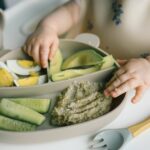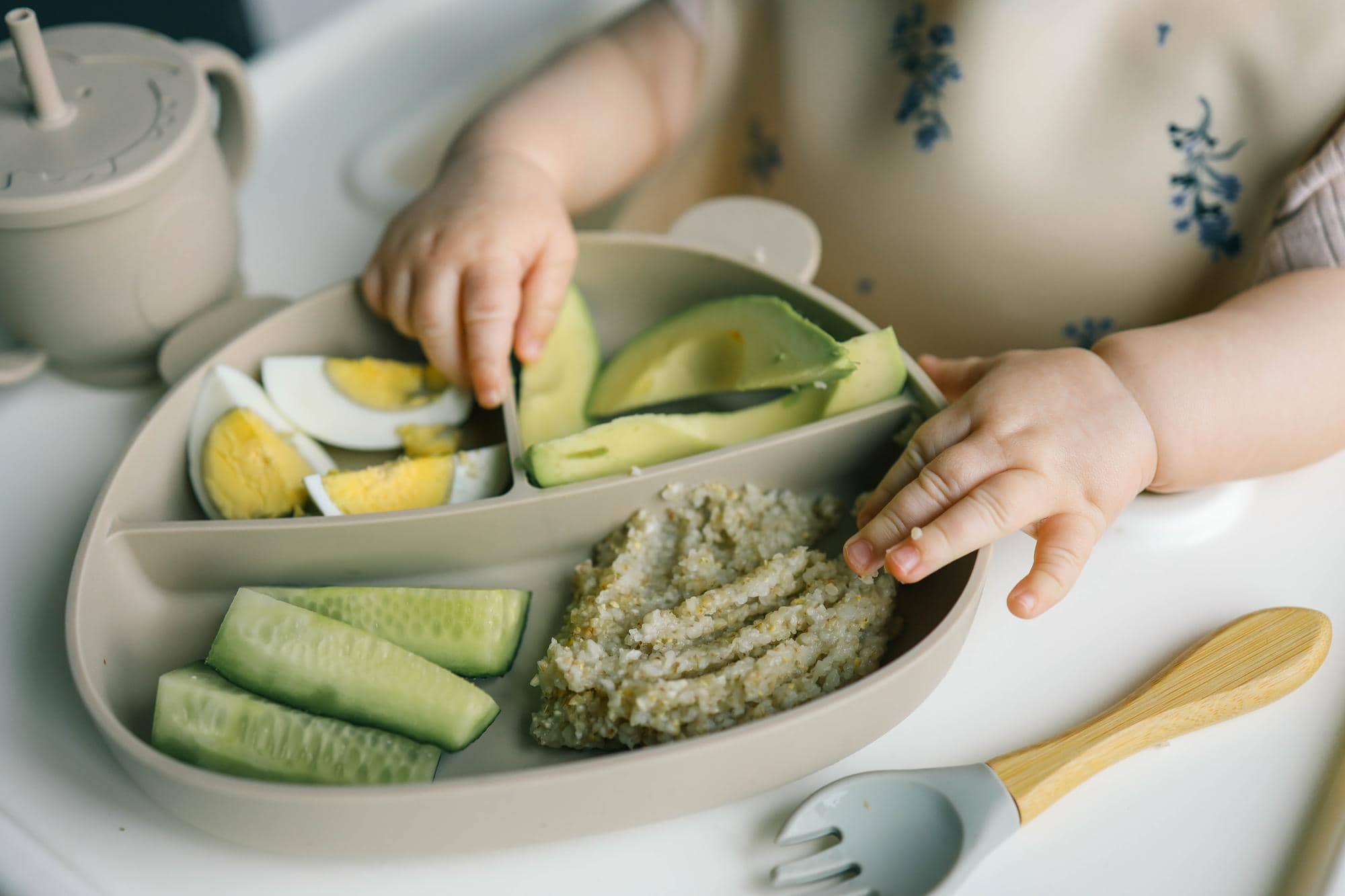Oh, the joys of motherhood! We cherish those sweet smiles, the endless cuddles… and, let's be honest, the constant juggling act, especially when it comes to getting a healthy meal on the table.
- What Exactly is Baby-Led Weaning?
- Why I Love BLW (and You Might, Too!)
- Flexibility and Realistic Expectations: Keeping it Real
- Time-Saving Tips for Us Busy Moms
- Easy-to-Prepare Finger Food Recipes
- Choosing Age-Appropriate Finger Foods
- Managing Mealtime Messes
- Ensuring Nutritional Balance
- Adapting BLW to Different Lifestyles
- Wrapping It Up
As a pediatrician and a mom of two wonderful girls, I know the struggle is real. If you're a busy mom like me thinking about baby-led weaning (BLW), you might be wondering how you'll ever find the time (or the energy!) to make it work.
But take heart, mama! I'm here to tell you that BLW can actually be a lifesaver for those of us with hectic schedules.
What Exactly is Baby-Led Weaning?
Baby-led weaning is simply letting your little one take the lead when introducing solid foods. Instead of spoon-feeding purees, you offer your baby soft, manageable pieces of food that they can explore and feed themselves. My youngest, who's four now, absolutely loved this! It was amazing to see her little hands pick up pieces of broccoli and banana. This approach helps babies develop their motor skills, become more independent, and create a healthy relationship with food. It's simply about a gradual shift from only breast milk or formula to a diet that includes solid foods along with continued milk feedings.
Why I Love BLW (and You Might, Too!)
BLW has so many benefits, both for babies and for us moms:
- It fosters independence: Babies learn to feed themselves and choose what and how much they eat. This can help them develop a sense of autonomy and confidence around food. My eight-year-old is a very adventurous eater, and I credit some of that to our early BLW days.
- It develops motor skills: Self-feeding helps babies with hand-eye coordination, chewing, and those fine motor skills as they learn to grasp different foods.
- It encourages healthy eating habits: Babies get to experience a wider variety of tastes and textures, which might make them less picky later on. By letting babies choose what they eat, BLW helps them understand their own hunger and fullness cues.
- It reduces mealtime stress: This one is huge for us busy moms! We don't have to make separate purees or worry about spoon-feeding, making mealtimes more relaxed. Studies have shown that mothers who use BLW report lower levels of stress during the weaning period.
- It encourages family meals: Babies can join in on family meals and eat (modified versions of) the same foods as everyone else. This promotes togetherness.
- It may help prevent food allergies: Introducing common allergens, like peanuts and eggs, early on is a proven way to reduce the risk of food allergies.
- It can be more budget-friendly: No need to buy special baby food! That's a win for any family budget.
Flexibility and Realistic Expectations: Keeping it Real
One of the most important things about BLW is flexibility. It's all about following your baby's lead and adapting to their needs. Some days they might eat a lot, other days they might not be interested at all. That's perfectly normal! Remember, breast milk or formula should still be the main source of nutrition for babies under a year old.
Responsive feeding is key. This means being present during mealtimes, paying attention to your baby's cues, and not pressuring them to eat. Trust your baby's ability to self-regulate. It's also important to have realistic expectations. Don't be discouraged if your baby doesn't take to BLW right away. It takes time and practice. Be patient and keep offering a variety of foods in a relaxed environment. And remember, it's okay to combine BLW with some spoon-feeding. You can offer purees alongside finger foods, especially for nutrient-dense foods like meat, to make sure your baby is getting everything they need.
Time-Saving Tips for Us Busy Moms
BLW can be surprisingly time-efficient, especially with some planning:
- Embrace batch cooking: Make big batches of baby-friendly meals on the weekend and freeze them in individual portions. This is a game-changer! Some of my freezer favorites include lentil and beef bolognese sauce, cheesy broccoli pasta, Swedish meatballs, sweet potato and lentil croquettes, banana oat pancakes, shepherd's pie, and butter chicken.
- Use your slow cooker: Slow cookers are a busy mom's best friend. Throw in the ingredients in the morning, and by dinner, you have a tender meal ready for everyone, including your baby.
- Simplify meal prep: Your baby doesn't need fancy meals. Focus on simple, nutritious foods that are easy to prepare.
- Offer finger food versions of family meals: Adapt your family meals. For example, if you're having roasted chicken and veggies, offer your baby soft-cooked chicken strips and steamed broccoli.
- Use pre-loaded spoons: If you want to introduce spoon-feeding, offer pre-loaded spoons with mashed foods. This lets your baby explore using a spoon but still have control.
- Offer water in an open cup: Encourage your baby to sip water from an open cup during mealtimes. This helps them develop their drinking skills.
- Create a calm mealtime environment: Try to avoid distractions like toys or screens. This lets your baby focus on their food.
- Make cleanup easier: Use a pitcher of warm water to wash your baby's hands and face after meals. This is a quick way to clean up without leaving the table.
Easy-to-Prepare Finger Food Recipes
Here are some quick and easy BLW recipes that are perfect for busy moms:
- Broccoli Bites: Steam broccoli and mash it with mozzarella, panko, garlic powder, and eggs. Bake until golden brown.
- Baby Pancakes: Blend oats, banana, milk, peanut butter (optional), and an egg. Cook like regular pancakes.
- Salmon Avocado Bites: Combine cooked salmon, mashed avocado, panko, onion powder, and an egg. Cook on a pan or bake.
- Sweet Potato Lentil Tater Tots: These are great to make ahead and freeze.
- Chickpea Pancakes: These savory pancakes are packed with protein and can be customized with veggies.
- Oat Milk Chia Pudding with Blueberry Orange Compote: A healthy breakfast or snack that can be made ahead of time.
Choosing Age-Appropriate Finger Foods
Offering age-appropriate finger foods is important for safety and to encourage successful self-feeding. Here's a general guide:
6-7 months
Avocado, banana, sweet potato, broccoli, well-cooked strips of meat or poultry.
8-9 months
Smaller pieces of soft fruits (blueberries, raspberries), diced cooked vegetables.
10-12 months
Gradually increase the size of food pieces as chewing skills improve.
Always supervise your baby during mealtimes and avoid choking hazards like whole grapes, nuts, and hard raw vegetables.
Managing Mealtime Messes
BLW can be messy, but there are ways to minimize it:
- Use a splat mat: Place a splat mat or an old shower curtain under the highchair.
- Invest in full-coverage bibs: Use bibs with sleeves or large pockets.
- Strip your baby down: At home, let your baby eat in just a diaper.
- Choose an easy-to-clean highchair: Opt for one with minimal crevices and a detachable tray.
- Clean up right away: Wipe up spills as soon as they happen.
- Embrace the mess: Remember that mess is a part of learning. Try to relax and enjoy the process.
Ensuring Nutritional Balance
While BLW encourages babies to self-regulate, it's important they get a balanced diet. Offer a variety of foods from all food groups:
- Iron and zinc-rich foods: Prioritize these early on, as they are essential for growth. Good sources are meat, poultry, fish, eggs, beans, lentils, and fortified cereals.
- Protein: Offer meat, poultry, fish, eggs, beans, lentils, tofu, cheese, and yogurt.
- Fruits and vegetables: Offer a rainbow of colors and textures for vitamins and minerals.
- Healthy fats: Include avocado, nut butters, and full-fat dairy.
For example, a balanced BLW meal might include strips of chicken, steamed broccoli, and a few pieces of soft-cooked sweet potato.
If you have concerns, talk to your pediatrician or a registered dietitian.
Adapting BLW to Different Lifestyles
BLW can fit different lifestyles and schedules. Whether you're a working mom, a stay-at-home mom, or somewhere in between, you can make it work.
- Working Moms: Use batch cooking and freezer meals. Talk to your childcare provider about your BLW preferences and give them suitable finger foods.
- Stay-at-Home Moms: Use naptime to prep meals and involve your baby in cooking. Enjoy relaxed mealtimes together.
- Families with Babies with Specific Needs: BLW can be adapted for babies with developmental differences or feeding challenges. You can use tools like silicone feeders and frozen straws. Talk to your pediatrician or a feeding therapist for guidance.
- Traveling Families: BLW can be easy to maintain while traveling. Pack finger foods and choose accommodations with kitchen facilities if you can.
Wrapping It Up
BLW can be a wonderful way to introduce your baby to food while fostering independence and healthy eating habits. By using time-saving strategies, choosing appropriate finger foods, and staying flexible, busy moms can make BLW a breeze. Remember to relax, enjoy the process, and trust your baby's ability to explore food at their own pace.
BLW offers many benefits for busy moms, including reduced mealtime stress, increased family togetherness, and the potential for preventing picky eating and food allergies. It's a flexible approach that can fit different lifestyles. Most importantly, it allows you to trust your baby's natural instincts and enjoy the journey of introducing them to the wonderful world of food.
How do you approach mealtimes with your little ones? Share your tips in the comments below!












